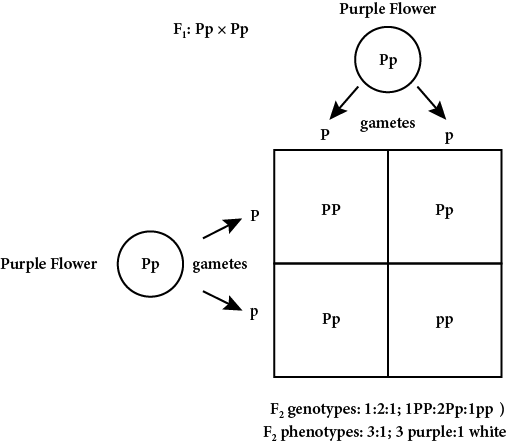
In the 1860s Gregor Mendel developed the basic principles of genetics through his experiments with the garden pea. Mendel studied the inheritance of individual pea traits by performing genetic crosses. He took true-breeding individuals (which, if self-crossed, produce progeny only with the parental phenotype) with different traits, mated them, and statistically analyzed the inheritance of the traits in the progeny.
Mendel postulated four principles of inheritance:
If two alleles in an individual organism are different, only one will be fully expressed, and the other will be silent. The expressed allele is said to be dominant, the silent allele, recessive. In genetics problems dominant alleles are typically assigned capital letters, and recessive alleles are assigned lowercase letters. Organisms that contain two copies of the same allele are homozygous for that trait; organisms that carry two different alleles are heterozygous. The dominant allele is expressed in the phenotype. This is known as Mendel’s Law of Dominance. For example, for the genotypes shown below, Yy and YY will both be yellow:
| Genes | Genotype | Phenotype |
|---|---|---|
| YY | Homozygous | Yellow |
| Yy | Heterozygous | Yellow |
| yy | Homozygous | Green |
The principles of Mendelian inheritance can be illustrated in a cross between two true-breeding pea plants, one with purple flowers and the other with white flowers. Because only one trait is being studied in this particular mating, it is referred to as a monohybrid cross. The individuals being crossed are the parental or P generation; the progeny generations are the filial or F generations, with each generation numbered sequentially (e.g., F1, F2, etc.).
The purple flower parent has the genotype PP (i.e., it has two P alleles) and is homozygous dominant. The white flower parent has the genotype pp and is homozygous recessive. When these individuals are crossed, they produce F1 plants that are 100 percent heterozygous (genotype = Pp). Because purple is dominant to white, all the F1 progeny have the purple flower phenotype.
One way of predicting the genotypes expected from a cross is by drawing a Punnett square diagram. The parental genotypes are arranged around a grid. Because the genotype of each progeny will be the sum of the alleles donated by the parental gametes, their genotypes can be determined by looking at the intersections on the grid. A Punnett square indicates all the potential progeny genotypes, and the relative frequencies of the different genotypes and phenotypes can be easily calculated.

When the F1 generation from our monohybrid cross is self-crossed (i.e., Pp × Pp), the F2 progeny are more genotypically and phenotypically diverse than their parents. Because the F1 plants are heterozygous, they will donate a P allele to half of their descendants and a p allele to the other half. One-fourth (25%) of the F2 plants will have the genotype PP, 50 percent will have the genotype Pp, and 25 percent will have the genotype pp. Because the homozygous dominant and heterozygous genotypes both produce the dominant phenotype purple flowers, 75 percent of the F2 plants will have purple flowers, and 25 percent will have white flowers.
This is a standard pattern of Mendelian inheritance. Its hallmarks are the disappearance of the silent (recessive) phenotype in the F1 generation and its subsequent reappearance in 25 percent of the individuals in the F2 generation. If we were to take a closer look at the physical characteristics of the plants themselves, we would find that the 1:2:1 genotypic ratio produces a 3:1 phenotypic ratio.

Mendel also developed the testcross, a diagnostic tool used to determine the genotype of an organism. Only with a recessive phenotype can the genotype be predicted with 100 percent accuracy. If the dominant phenotype is expressed, the genotype can be either homozygous dominant or heterozygous. Thus, homozygous recessive organisms always breed true. This fact can be used to determine the unknown genotype of an organism with a dominant phenotype, such as when an organism with a dominant phenotype of unknown genotype (Ax) is crossed with a phenotypically recessive organism (genotype aa). Since the recessive parent is homozygous, it can donate only the recessive allele, a, to the progeny. If the dominant parent’s genotype is AA, all of its gametes will carry an A, and all of the progeny will have genotype Aa. If the dominant parent’s genotype is Aa, half of the progeny will be Aa and express the dominant phenotype, and half will be aa and express the recessive phenotype. In a testcross, the appearance of the recessive phenotype in the progeny indicates that the phenotypically dominant parent is genotypically heterozygous.

The segregation principle provides a satisfactory explanation for the inheritance of a single allele and also can be extended to a dihybrid cross, in which the parents differ in two traits, as long as the genes are on separate chromosomes and assort independently during meiosis. Mendel postulated that the inheritance of one such trait is completely independent of any other. In this way, a plant with purple flowers is no more likely to be a dwarf than a plant with white flowers (see the example below). This is known as Mendel’s Law of Independent Assortment.
Note that according to modern, non-Mendelian genetics, genes on the same chromosome will not follow this rule and instead will stay together unless crossing over occurs (see Chapter 8, Cellular Biology). Nevertheless, crossing over exchanges information between chromosomes and may break the linkage of certain patterns. For example, red hair is usually linked with freckles, but some blondes and brunettes have freckles as well. Generally, the closer the genes are on the chromosome, the more likely they are to be inherited together.
In the following example, a purple-flowered tall pea plant is crossed with a white-flowered dwarf pea plant; both plants are doubly homozygous (tall is dominant to dwarf, T = tall allele, t = dwarf allele; purple is dominant to white, P = purple allele, p = white allele). The purple parent’s genotype is TTPP, and it thus produces only TP gametes; the white parent’s genotype is ttpp and produces only tp gametes. The F1 progeny will all have the genotype TtPp and will be phenotypically dominant for both traits.
When the F1 generation is self-crossed (TtPp × TtPp), it produces four different phenotypes: tall purple, tall white, dwarf purple, and dwarf white, in the ratio 9:3:3:1, respectively. This is the typical pattern for Mendelian inheritance in a dihybrid cross between heterozygotes with independently assorting traits.

Modern work with the fruit fly (Drosophila melanogaster) helped to provide explanations for Mendelian genetic patterns. The fruit fly possesses several advantages for genetic research:
Through genetic and mutational analyses of D. melanogaster, scientists have elucidated the patterns of embryological development, discovering how genes expressed early in development can affect the adult organism.